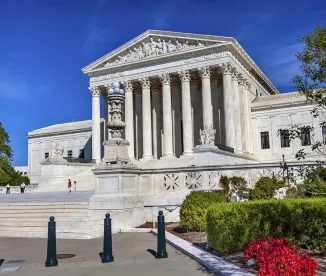Since the Supreme Court’s decision in Basic Inc. v. Levinson, 485 U.S. 224 (1988), plaintiffs have been permitted to invoke a rebuttable presumption of class-wide reliance at the class certification stage in securities fraud cases, thereby skirting any obligation to establish individualized reliance for each member of the proposed class. In Halliburton Co. v. Erica P. John Fund, Inc., 573 U.S. 258 (2014), the Supreme Court clarified that defendants must be afforded an opportunity to rebut this presumption, and cautioned judges not to “artificially limit” the types of rebuttal evidence a defendant may offer, even if such evidence “is also highly relevant at the merits stage.” Id. at 283-84. In recent years, courts have differed in determining whether and how this presumption can and should be rebutted. On December 11, the Supreme Court granted certiorari in Goldman Sachs Group Inc. v. Arkansas Teacher Retirement System, No. 20-222, signaling an intent to further clarify the law in this area by evaluating the Second Circuit’s decision in Arkansas Teacher Retirement System v. Goldman Sachs Group., Inc., 955 F.3d 254 (2d Cir. 2020). This GT Alert provides an overview of the Basic presumption, the Arkansas Teacher case, and the potential impact of the high court’s review on putative securities fraud class actions moving forward.
Basic and Its Progeny – The Rebuttable Presumption of Class-Wide Reliance
In Basic, the Supreme Court established the rebuttable presumption of class-wide reliance, basing it on the so-called “fraud on the market” theory, which posits that “‘in an open and developed securities market, the price of a company’s stock is determined by the available material information regarding the company and its business,’” including material misstatements. 485 U.S. at 241-42 (citation omitted). As explained by the Court, a typical “investor who buys or sells stock at the price set by the market does so in reliance on the integrity of that price” – i.e., the belief that it reflects all material information. See id. at 247. Accordingly, the investor’s “reliance on any public material misrepresentations … may be presumed for purposes of a Rule 10b-5 action.” Id.
The Court in Basic did emphasize that this presumption may be rebutted in any number of ways, such as by “show[ing] that the misrepresentation in fact did not lead to a distortion of price” – i.e., that it had no “price impact.” See id. at 248. According to the Court, “[a]ny showing that severs the link between the alleged misrepresentation and either the price received (or paid) by the plaintiff, or his decision to trade at a fair market price, will be sufficient to rebut the presumption of reliance.” Id. The Supreme Court reiterated the rebuttable nature of the presumption in Halliburton, wherein it distinguished consideration of “price impact” from consideration of materiality, which generally “should be left to the merits stage.” 573 U.S. at 282-83. The Court held that “defendants must be afforded an opportunity before class certification to defeat the [Basic] presumption through evidence that an alleged misrepresentation did not actually affect the market price of the stock.” Id. at 284 (emphasis added).
Arkansas Teacher: Do Generic Purported Misrepresentations Suffice, and Other Burden Issues
In 2011, shareholders brought a purported securities fraud suit against Goldman Sachs and three of its former executives (collectively, GS), alleging GS had misrepresented the existence of conflicts of interest surrounding several collateralized debt obligation (CDO) transactions involving subprime mortgages, and that Plaintiffs were purportedly injured after those conflicts were revealed in, among other things, a 2010 SEC complaint, and GS’s stock price dropped. After discovery, Plaintiffs moved for class certification, invoking the Basic presumption of class-wide reliance. The district court granted the motion and held that GS had failed to meet its burden to rebut the presumption, notwithstanding evidence that GS’s stock had not decreased on at least 34 occasions when the media had reported on the alleged conflicts prior to the filing of the SEC complaint. The court reasoned that such evidence “speaks to the statements’ materiality and not to price impact,” and thus should not be considered at this stage. In re Goldman Sachs Grp., Inc. Sec. Litig., No. 10-CV-3461, 2015 U.S. Dist. LEXIS 128856, at 20 (S.D.N.Y. Sept. 24, 2015).
On appeal, the Second Circuit unanimously vacated the decision, reasoning that the district court had failed to apply the proper standard in considering whether the presumption invoked by Plaintiffs had been rebutted (i.e., by a preponderance of the evidence). Arkansas Teachers Ret. Sys. v. Goldman Sachs Grp., Inc., 879 F.3d 474, 485 (2d Cir. 2018). In so holding, however, the Second Circuit reasoned that a defendant seeking to rebut the Basic presumption bears the ultimate burden of persuasion, notwithstanding the language of Federal Rule of Evidence 301. See id. at 484. Notably, in contrast, the Eighth Circuit had previously cited Rule 301 for the proposition that a defendant need only “come forward with evidence showing a lack of price impact,” suggesting that the ultimate burden of persuasion may remain with plaintiffs. IBEW Local 98 Pension Fund v. Best Buy Co., 818 F.3d 775, 782 (8th Cir. 2016). The Second Circuit also held that the district court should have considered evidence that GS’s stock price had not decreased when the media reported on the company’s alleged conflicts of interest prior to 2010, as such evidence was relevant to the “fundamental” issue of price impact. See 879 F.3d at 486 (citing Halliburton).
On remand, the district court again granted class certification. See In re Goldman Sachs Grp., Inc., No. 10-CV-3461, 2018 U.S. Dist. LEXIS 137414 (S.D.N.Y. Aug. 14, 2018). This time, the court considered the evidence that GS’s stock price had not moved, but then held that “[t]he absence of price movement … in and of itself, is not sufficient to sever the link between the first corrective disclosure and the subsequent stock price drop.” Id. at *14. The court held that GS (not Plaintiffs) bore the burden of persuasion to rebut the Basic presumption by a preponderance of the evidence, id. at *8, and that GS had failed to do so. See id. at *13-19.
On appeal, a new Second Circuit panel affirmed in a 2-1 decision. Among other things, the majority rejected the GS argument that “general statements” are legally insufficient for Plaintiffs to invoke the Basic presumption. See 955 F.3d at 266. The court reasoned that applying such a rule would effectively require consideration of whether the alleged misstatements were “immaterial as a matter of law,” and thus functioned as “a means for smuggling materiality into” the class certification analysis. See id. at 267. The majority also rejected the argument that GS had met its rebuttal burden, reasoning that the lower court “applied the correct legal standard and reasonably concluded by a preponderance of the evidence that the [SEC complaint and other] disclosures revealed new and material information to the market.” Id. at 271.
Judge Richard J. Sullivan dissented, stating that the majority was “miss[ing] the forest for the trees” and “essentially turning the [Basic] presumption on its head.” Id. at 275. Although he did not take issue with the determination that GS bore the burden of persuasion, in his view, GS had met that burden anyway. Id. He also reasoned that “it’s fair for this court to consider the nature of the alleged misstatements in assessing whether and why ‘the misrepresentations did not in fact affect the market price of Goldman stock.’” Id. “Candidly,” he stated, “I don’t see how a reviewing court can ignore the alleged misrepresentations when assessing price impact. Here the obvious reason for why the share price didn’t move after 36 separate news stories on the subject of Goldman’s conflicts is that no reasonable investor would have attached any significance to the generic statements on which Plaintiffs’ claims are based.” Id.
Petition for and Grant of Certiorari and Potential Ramifications of Arkansas Teacher
GS’s August 21, 2020, petition for certiorari, which was granted on December 11, raises two questions for appeal: (1) whether the Basic presumption can be rebutted by pointing to the generic nature of the alleged misstatements in showing that the statements had no impact on the price of the security, and (2) whether a defendant has both the burden of production in rebutting the presumption as well as the ultimate burden of persuasion, or whether that ultimate burden rests with the plaintiff.
As to the first question, GS challenges the Second Circuit’s holding that consideration of the generic nature of the alleged misstatements would improperly address materiality at the class certification stage. Per GS’s petition, that conclusion is contrary to Halliburton’s instruction that courts should not craft “artificial[] limit[s]” between merits and price-impact evidence in deciding class certification motions. See Pet. at 19. GS notes that in In re Allstate Corp. Secs. Litig., 966 F.3d 595, 608 (7th Cir. 2020), the Seventh Circuit recently reversed a district court for refusing to consider expert testimony on price impact closely related to the merits at the class certification stage. As to the second question, GS argues that Arkansas Teacher “perpetuates a conflict” among the federal appellate courts on whether defendants bear the ultimate burden of persuasion on the question of price impact. See Pet. at 21. Six groups of amici curiae filed briefs in support of GS’s petition, urging the Supreme Court to review the Second Circuit’s decision; in contrast, no amicus briefs were filed in support of the shareholders’ opposition.
The oral argument and ultimate decision in Arkansas Teacher – which is anticipated before the end of the Supreme Court’s current term in June 2021 – will no doubt be watched closely by publicly traded companies and their officers. The Second Circuit’s decision has been described by industry groups as shifting the balance established by Basic, Halliburton, and their progeny to make it easier for securities fraud plaintiffs to secure class certification, namely by (1) placing upon defendants the ultimate burden to show the absence of price impact, while at the same time (2) hamstringing defendants’ ability to satisfy that burden by precluding them at the class certification stage from relying on price impact evidence that also touches on materiality and other merits issues. At a minimum, it has also generated a new level of unpredictability in how courts will address class certification motions in securities fraud litigation. As the Second Circuit majority in Arkansas Teacher acknowledged, different judges might reach different conclusions concerning the persuasiveness of rebuttal evidence, making securities fraud class certification decisions increasingly inconsistent. The Supreme Court may provide firmer guidance on how the presumption should be applied and rebutted.
Finally, Arkansas Teacher presents another opportunity for the Supreme Court to clarify which party bears the ultimate burden of persuasion with respect to the Basic presumption. The Supreme Court’s election to hear Arkansas Teacher is a change of course from just two years ago, when it denied a petition raising the same burden question. See Barclays PLC v. Waggoner, No. 16-1912 (2018). GS’s argument that defendants carry a mere burden of production, whereas the burden of persuasion remains with plaintiffs, finds some support in Federal Rule of Evidence 301, the Eighth Circuit’s IBEW decision, and in a number of district court opinions. See, e.g., Bing Li v. Aeterna Zentaris, Inc., 324 F.R.D. 331, 344 (D.N.J. 2018) (granting class certification based on Basic presumption, but characterizing defendant’s burden as one to “produc[e] evidence to rebut the presumption” sufficient “to withstand motion for summary judgment”); KBC As-set Management NV v. 3D Systems Corp., No. 15-2393, 2017 U.S. Dist. LEXIS 159781, at *22 (D.S.C. Sept. 28, 2017) (granting class certification, but citing IBEW on defendants’ burden). Since the Second Circuit’s decision in Arkansas Teacher, however, the Seventh Circuit has agreed that the burden of persuasion is on defendants. See Allstate, 966 F.3d at 610 & n.4 (vacating class certification order based on factual dispute as to price impact, but holding that Defendant bore burden of persuasion). Supreme Court review may thus address this important question.
All eyes remain on how the Supreme Court takes on these issues. In the meantime, defendants, at least in the Second and Seventh Circuits, should be prepared to arm themselves with the most persuasive evidence available to effectively and fully rebut the Basic presumption.




 />i
/>i
